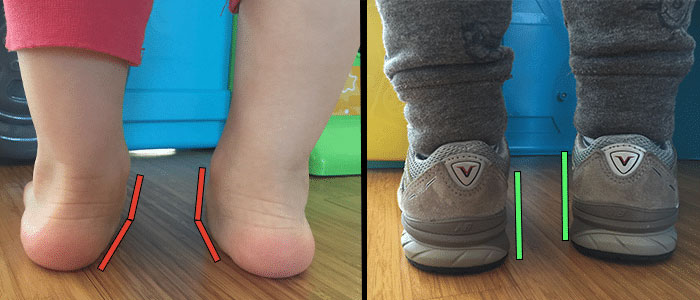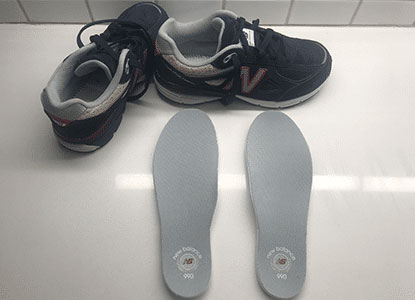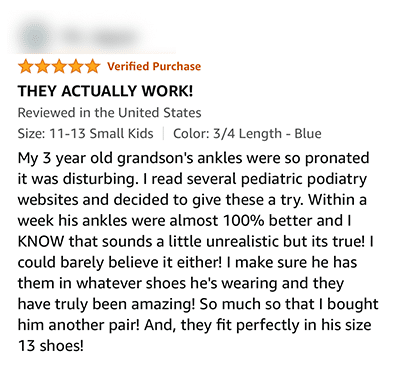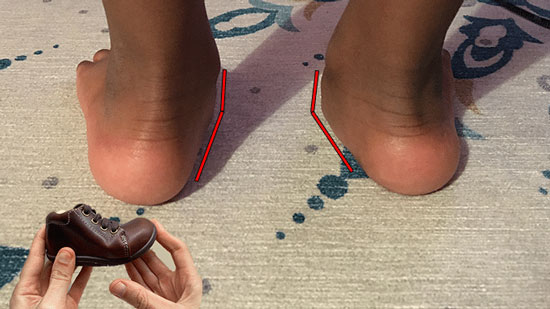Best Orthotics for Kids with Mild Pronation – Prevent Your Kids’ Feet from Rolling Inwards

Have you noticed your child standing and walking differently lately? Have you taken your child to your medical professional and was diagnosed with mild pronation? There are three different degrees of pronation:
- Mild
- Moderate
- Strong
Is Pronation Common in Children?
It’s important to keep in mind that pronation is common. We all have a certain degree of pronation, but when that pronation becomes excessive it can lead to poor posture habits as well as foot and leg pain.
Once the feet are pronated, the knees and hips also become misaligned. This means that the muscles that move those joints no longer work efficiently, and it will take more energy for your child to do the same work as other children who don’t have this condition.
What is Mild Pronation?
Mild pronation occurs when the child’s foot and ankle roll inwards slightly, causing the child to walk and stand on the inside part of the foot.
If you look at your child’s feet from behind you will notice the arch of your child’s foot is either reduced or gone altogether.

Your child’s body is always growing and changing, so don’t rush to your medical professional as soon as you notice a slight rolling of your child’s feet or ankles. However, it’s important to not leave your child’s pronation untreated as it might cause your child a biomechanics problem at some point in your child’s life. It might not be on the foot, it might be the knee, the hip, the back, and all of the structures and joints above the feet depend on the feet.
In my experience, if a child has not developed an arch over the age of 5, the child will likely remain flat-footed for the rest of his/her life.
How to Treat Your Child’s Mild Pronation?
The correct types of shoes and orthotics can make a world of difference when it comes to improving your child’s foot posture and walking gait.
Providing your child with the correct type of orthotic can improve your child’s foot posture and walking gait by mechanically supporting the pieces of the foot that causes the foot to be flat such as the heels.
It is amazing how something so simple such as fitting a child in the correct type of orthotics can improve the child’s walking gait, balance, and overall posture!
I have tested several different types of orthotics, but there is one specific orthotic that has been specifically designed by podiatrists to correct the misalignment caused by flat feet and rolled ankles. I will show you this orthotic shortly, but first, let me show you what a difference the correct type of orthotic can make in improving a child’s foot posture.
What a Difference the Correct Type of Orthotic and Shoes Can Make!
Let’s take a look at a child with mild pronation standing barefoot. Do you notice how in the left image the child’s feet and ankles are rolling inwards slightly? Take a look in the right image at how straighter the feet are when the child is fitted in a pair of supportive shoes and orthotics I recommend.

Wow! What a difference the correct pair of shoes and orthotics can make!
Keep in mind that the shoes and orthotics work together helping treat your child’s mild pronation. It’s important that the orthotics are fitted inside the correct types of shoes for your child to get the full benefits that the orthotics have to offer.
Best Orthotics for Kids with Mild Pronation
The main reason why I recommend this orthotic is that it provides excellent arch and heel support, and at the same time is not as invasive as other orthotics. This means that this orthotic allows your toddler’s foot and leg muscles to develop on their own while supporting them.
- Fits a toddler shoe size 5 up to a big kid shoe size 3
- Medically approved insoles with targeted cushion and support
- Deep heel cup with strong arch support
- Made from lightweight yet supportive cushioning material with shock-absorbing heel padding
- Forefoot padding to increase comfort
- They can be trimmed to size with scissors if needed
Don’t Forget to Remove the Original Insoles of Your Kids’ Shoes
I strongly suggest that you remove the original insoles of your kids’ shoes before placing the new orthotics/insoles inside the shoes:

What Are Other Families Saying About These Insoles/Orthotics?



How to Tie Shoes with Orthotics?
If your child is wearing a pair of shoes with laces instead of velcro closure, I suggest that you apply the a specific shoe lacing technique to secure your child’s heels and prevent them from slipping out of the shoes.
Does Your Child Have Moderate to Strong Pronation?
Keep in mind that the orthotics/insoles I recommended work best for cases of mild pronation. If your child has moderate or strong pronation I suggest at the article on best orthotics for kids with moderate or strong pronation.
What Are the Best Shoes for Kids with Mild Pronation?
As I mentioned before, the shoes and the orthotics work together to help treat your child’s mild pronation.
I suggest looking for shoes that provide substantial outsoles, firm heel counters, and straight lasts. In addition, the shoes must fit the shape of your child’s feet correctly (narrow, medium, wide, extra wide).
There is only a small selection of shoes that work well with orthotics, but the good news is that I will help you find them. If you are unsure about what types of shoes to provide for your child who wears orthotics I suggest that you take a look at the resource at the best sneakers for orthotics.
The Final Fitting – Be Proactive!
When pronation is left untreated, it can lead to your child living a more sedentary life in which she/he might be more inclined to sit rather than play.
I always recommend parents to be proactive and don’t take the “wait and see approach” when it comes to treating their children’s foot conditions. Leaving your children’s foot conditions untreated can only lead to the condition getting worse.
Do not hesitate to contact me if the orthotic I recommend is not available in your child’s foot size or if you are unsure about which shoes will work best for your child’s pronation.




